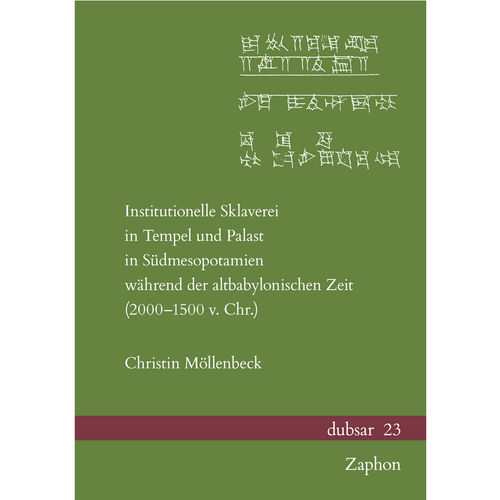Institutionelle Sklaverei in Tempel und Palast

Institutionelle Sklaverei in Tempel und Palast in Südmesopotamien während der altbabylonischen Zeit (2000–1500 v. Chr.)
Christin Möllenbeck
dubsar 23
2021
ISBN 978-3-96327-166-3 (book)
ISBN 978-3-96327-167-0 (e-book, via ProQuest)
XII + 450 pp. / 17 x 24 cm / thread stitching, hardcover
| Summary |
In the present work, slavery in southern Mesopotamia during the Old Babylonian period (ca. 2000–1595 BC) is examined in the institutional realm of the temple and palace. For decades, research on slavery has played an important role in historical science from a social, historical and economic perspective. While slavery is considered a global historical phenomenon that has existed throughout human history, research into slavery in the premodern eras has focused primarily on Graeco-Roman antiquity, although ancient Mesopotamia has numerous sources on slavery dating back to going back to the beginnings of historical records. Although the first treatises on slavery in the Ancient Near East were written at the beginning of the 20th century, these studies – up to the present day – have only rarely been noticed outside of Ancient Near Eastern Studies. The study is based on the relevant texts from 16 sites in southern, central and northern Babylonia, with the following four aspects in focus: The Acquisition of Slaves: Determining the sources of slavery is a fundamental part of the study. A distinction is made here between acquisition through purchase, captivity, dedication and hiring. In the course of acquisition through one of the options mentioned, the origin of the slaves is also examined, which is often noted in the texts at the time of admission to an institution. Tasks and areas of use of the slaves: The tasks and areas of use of the slaves and thus their contribution to the functioning of institutional households are also of particular interest. These are agriculture, handicrafts and the cult area. The supply of the slaves: The supply lists of the political and cultic-religious institutions often represent the only proof of the existence of slaves. They are evaluated primarily with regard to the qualifications and the areas of application of the slaves. Redemption, release, escape and death of slaves: A slave could evade the violence of a political or cultic-religious institution by paying a ransom, fleeing, release or death. It becomes clear that slaves could be used in every economic area of the palace and temple households – agriculture, handicrafts and even in the cult – and thus contributed to the functioning of the palace and temple economy. The work can also show how closely the private sector was able to work with the respective institutions.
|
|---|---|
| Table of Contents |
Vorwort I. Teil: Raum – Zeit – Gegenstand 1. Einleitung 2. Zur altbabylonischen Zeit und ihren Quellen 3. Gegenstand 3.1. Sklaverei im Alten Orient – Stand der Forschung und Begriffsbestimmung 3.2. „Tempel“, „Palast“ und die Trennung zwischen „privat“ und „offiziell“ II. Teil: Institutionelle Sklaverei in den altbabylonischen Texten Mesopotamiens 1. Ur 1.1. Einleitung 1.2. Das relevante Textmaterial 1.3. Die a-ru-a-Texte und der Nanna-Ningal-Tempel 1.4. Anlass der Weihung und Einsatz im Tempel 1.5. Weitere Belege für Sklaven im Nanna-Ningal-Tempel 1.6. Fazit 2. Larsa 2.1. Einleitung 2.2. Das relevante Textmaterial 2.3. Das bīt asīrī 2.4. Balmunamḫe – der Verwalter des Enki-Tempels? 2.5. Das Ebabbar 2.6. Sklavenstiftungen an Gottheiten 2.7. Der Palast des Nūr-Adad 2.8. Versorgungslisten 2.9. Diverse administrative Texte 2.10. Fazit 3. Uruk 3.1. Einleitung 3.2. Das relevante Textmaterial 3.3. „Gefangener“ oder „Sklave“? 3.4. Eigenschaften und Herkunft der Gefangene und Sklaven 3.6. Gefangene und Sklaven innerhalb der Verwaltungsstrukturen von Uruk 3.7. Die Verfügungsgewalt über Gefangene und Sklaven des bīt asīrī 3.8. Ein flüchtiger Palastsklave 3.9. Fazit 4. Kisurra 4.1. Einleitung 4.2. Sklaven im c-Haushalt 4.3. Fazit 5. Isin 5.1. Einleitung 5.2. Sklavinnen im Enlil-bāni-Palast 5.3. Sklavinnen im „Craft Archive“ 5.4. Fazit 6. Nippur 6.1. Einleitung 6.2. Das Archiv des „central redistributive household“ 6.3. Sklavinnen und Sklaven im Ninurta-Tempel 6.4. Brot für die géme-uš-bar „Sklavinnen-Weberinnen“ 6.5. Fazit 7. Dūr-Abiešuḫ 7.1. Einleitung 7.2. Das relevante Textmaterial 7.3. Preise und Herkunft der Sklaven 7.4. Institutioneller oder privater Kontext? 7.5. Fazit 8. Maškan-šapir 8.1. Einleitung 8.2. Versorgung von Kriegsgefangenen durch den gu-za-lá 8.3. Fazit 9. Babylon 9.1. Einleitung 9.2. Sklaven und Sklavinnen im Haus des Marduk-nāsir 9.3. Sklaven für das Mahlen im Marduk-Tempel 9.4. Fazit 10. Tell Egraineh 10.1. Einleitung 10.2. Die Versorgung von Sklavinnen und Sklaven im Uraš-Tempel 11. Damrum und die Mananâ-Texte 11.1. Einleitung 11.2. Kriegsgefangene aus Ešnunna 11.3. Fazit 12. Sippar 12.1. Einleitung 12.2. Der TIM-VII-Haushalt 12.3. Sklaven im gagûm-Kloster 12.4. „Sklaven des Hauses“ (außerhalb des TIM-VII-Haushalts) 12.5. Sklaven im Tempel der Annunītum (Eulmaš) 12.6. Sklaven für den Tempel des Šamaš (Ebabbar) 12.7. Sklaven im Palast 12.8. Die Weihung von Sklaven an eine Gottheit im Zuge einer Adoption 12.9. Fazit 13. Šaduppûm 13.1. Einleitung 13.2. Das Hauptverwaltungsgebäude „Serai“ 13.3. Fazit 14. Nērebtum 14.1. Einleitung 14.2. Der Kitītum-Tempel 14.3. Einige Sklavenkaufurkunden aus institutionellem Kontext 14.4. Lösegeldvereinbarungen zwischen Šadlaš und Nerēbtum 14.5. Fazit 15. Tutub 15.1. Einleitung 15.2. Texte aus dem Sîn-Tempel 15.3. Fazit 16. Ešnunna 16.1. Einleitung 16.2. Der Austausch von Kriegsgefangenen 16.3. Sklaven und Sklavinnen in den administrativen Texten des Palastes und des Šu-Sîn-Tempels 16.4. Fazit III. Teil: Auswertung und Zusammenfassung 1. Institutionen zwischen Tempel, Palast und Privatwirtschaft 2. Die Sklaverei in politischen Institutionen 2.1. Der Erwerb von Sklaven 2.2. Die Aufgaben und Einsatzbereiche der Sklaven 2.3. Die Versorgung der Sklaven 2.4. Auslösung, Freistellung, Flucht und Tod von Sklaven 2.5. Chronologische Verteilung der Sklaverei in politischen Institutionen 3. Die Sklaverei in kultisch-religiösen Institutionen 3.1. Der Erwerb von Sklaven 3.2. Die Aufgaben und Einsatzbereiche 3.3. Die Versorgung der Sklaven 3.4. Chronologische Verteilung der Sklaverei in kultisch-religiösen Institutionen 4. Fazit und Ausblick IV. Teil: Anhang 1. Abkürzungsverzeichnis 2. Bibliographie 3. Abbildungsverzeichnis 4. Index |
